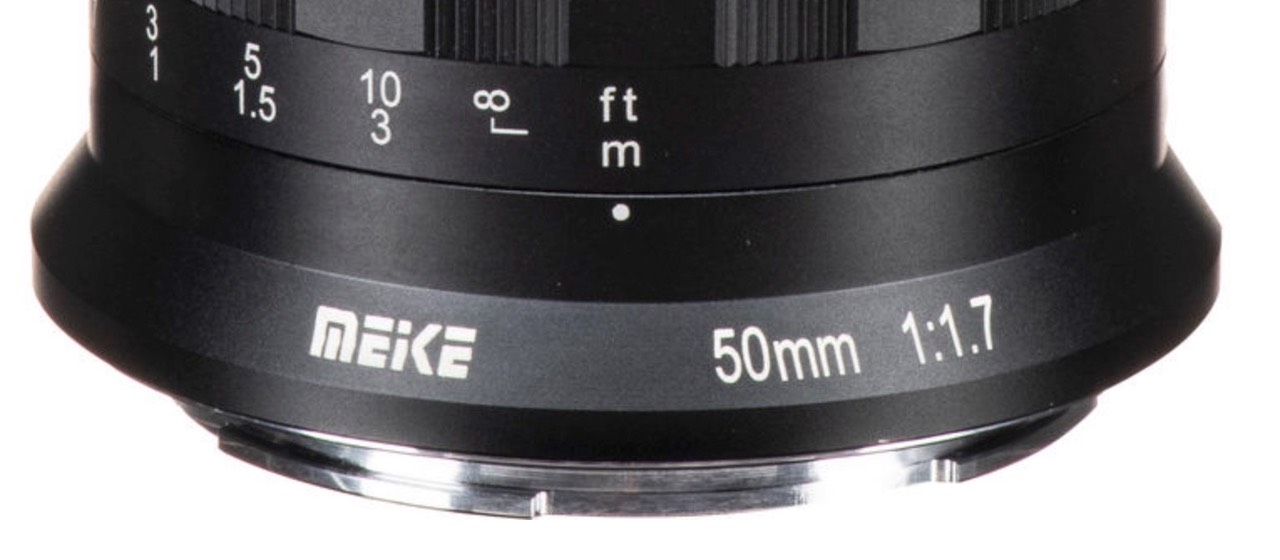What is It?
The Meike 50mm f/1.7 was a bit of a surprise for the Z mount. Meike, a Chinese photography equipment outlet, had been rebranding a number of APS-C lenses for mirrorless camera mounts, but this full frame 50mm f/1.7 popped up almost immediately after the Nikon Z announcement (and it comes in Canon RF and Sony FE mounts, as well).
One reason why that was possible: there are no electrical contacts and this is a manual focus lens. Thus, really the only thing that needed to be changed was to build out the actual mount itself from the FE mount version that had just been introduced. As you might be able to tell from the photo, above, the Z mount is wider than the lens, thus there's a slight slope from the barrel of the lens to the outer ring of the Z mount. Here's a closer look at that:

In terms of physical characteristics, this is a simple lens with an optical design probably copied from an old film lens. That means 6 elements in 5 groups, with no fancy aspherical or low dispersion glass. There is a multi-layer coating to reduce flare, but other than that, this lens is probably as close to something we used in the 60's and 70's as you can get with a modern lens mount.
Close focus distance isn't particularly close at 20" (0.5m). But that plus the old-school design has kept the lens relatively small (at 2.4", 61mm) long and light (at 10.9 ounces, 310g despite having an all-metal lens barrel). The lens is also narrow enough so that it takes 52mm filters.
There's not much else to be said. Again, this is a simple lens, which is probably why it was available so fast for the Nikon Z mount.
Source of the reviewed lens: purchased
How's it Handle?
The aperture ring is surprisingly not clicked. It's also very smooth in operation. Clearly Meike was thinking videographer with this decision. The still photographer, however, has to worry about possibly dislodging the ring and accidentally setting a different aperture, though. Not a big deal, but since the lens has no electronic communication to the camera, there's no way to know what the lens is set for unless you look at the aperture ring itself.
Moreover, you can't set 50mm and f/1.7 in the non-CPU lens data, anyway.
So you'll be setting exposure visually or via the on-screen histogram of the Z cameras.
The focus ring has a distinct scalloped ring, and is also very smooth. Near to far focus happens in about a quarter turn. Unfortunately, there are no DOF markings on the lens.
Note also that the lens doesn't have a lens mount alignment market at the back. Meike relies upon the old rule: the small dot that's the focus marker is the alignment mark, but it's not at the rear of the lens where you're align it to the camera's dot, and it's small and sometimes tough to see.
Finally, the lens comes with a small, thin carry bag, plus a lens hood. Does the lens fit in the bag with the hood on? No. Can you take the hood off and fit both it and the lens in the bag? Not really. Oh so close... Worse still, the lens hood doesn't lock into place on the lens, so it is easily dislodged.
That said, the lens is really nicely built, with a solid build quality.
How's it Perform?
Sharpness: surprisingly good for the price. The simple and traditional optical design seems to do the job. But 50mm at this aperture is a low design bar; edge performance is quite decent wide open. I'd characterize the sharpness wide open as close to excellent in the middle of the frame, very good at the DX boundary, good at the borders.
The lens continues to improve to about f/5.6, which I'd judge to be its optimal aperture. At that point, both the center and edge of frame are very good to excellent. But overall contrast is a little on the low side compared to some 50mm lenses. That's actually what I want for taking people photos or shooting video, so I don't find that a real problem.
If the lens has a weakness, it's near its close focus point (see image below), where there's a slight drop off in edge acuity, and again, the overall contrast is not at all punchy. It almost looks like a slight anti-aliasing or diffraction effect. Actually, some people like that. For video, for instance, this lens tends to have that traditional non-edgy look. And indeed, I've been most happy with this lens as a video lens.

Hint: with focus peaking, you need to switch your peaking color when you encounter subjects like this. Focus peaking is set to red by default on the Z6 and Z7, but changing it to yellow worked fine here for me to figure out where the focus was.
Chromatic Aberration: where the old, simple optical formulas like this one tend to have issues is in other areas than overall sharpness; things like chromatic aberration. This Meike is no exception: chromatic aberration becomes a clear issue as you move towards the edge of the frame, and this gets worse as you stop down. The CA isn't terrible, but you're probably going to find a number of situations where you want to correct it. The one place where I'd tend to avoid using the lens is for high contrast subjects, like back-lit trees in landscapes.
Linear Distortion: modest barrel distortion right near the boundary of where I may or may not correct it (about half a percent). For straight-line subjects, I'll tend to, for everything else no.
Vignetting: Clear vignetting at f/1.7 and f/2, which tends to go away and be ignorable at f/4. That said, the vignetting circle is fairly wide (e.g. the DX frame area is fairly even with the lens wide open; it's the deep corners that show more dramatic change).
Bokeh: Relatively pleasing, particularly for non-point sources that are out of focus. Backgrounds behind portraits tend to have that old-school look when they go out of focus, where they tend to just go a dreamy level of soft. However, point light sources show colored, brighter edges (from longitudinal CA, it appears). At f/2.8 my sample has a more elliptical aperture look on those point sources, and this doesn't go away until about f/5.6 (at f/2 I don't see the effect, nor at f/16).
Flare: Didn't seem to be an issue shooting into the light most of the time, though I do note that fine high-contrast detail has a tendency to fuzz out and light rays go rainbow more easily in back-lit situations, which I'd tend to believe has something to do with lack of coatings on some elements (Meike claims a multi-layer coating).
Final Words
Just buy one if you're interested. At US$140, this shouldn't be a challenge for most of you.
Yeah, it doesn't autofocus and nailing exposure can be a little troublesome at times as the lens is not electronically coupled to the Z cameras, but this is a pretty well-behaved little lens, and focus peaking is your friend. I mentioned "old school" in terms of bokeh above, and that's definitely the impression I got here. The focus-to-out-of-focus rendering is somewhat pleasant, and reminds me of a lot of other older and simple MF lenses.
The Nikkor 50mm f/1.8 S is a bit more modern and cutting in its rendering. I'd actually prefer the Meike to the Nikkor for upper body shots shot wide open on video, I think. It's close. And thus, if you're hesitant about paying US$600 for the Nikkor, the inexpensive Meike is probably going to look quite good to you (sorry about the lack of electronics ;~). Moreover, for video, you're no longer fiddling with focus-by-wire.
Another thing: everyone should have an inexpensive lens for those times when you're not sure what's going to splash up and hit the front element. You don't want to potentially ruin your expensive lens when standing out in the ocean trying to catch surfers, or standing on the edge of a volcano that's spewing noxious gasses that might damage coatings, or...well, you get the idea. This is the type of lens I often use in those situations, and I'm not really feeling like I'm giving up too much optically.
Let me put it a different way: this is a good lens for its price. Perhaps even a very good lens. And it quickly turned into a lens that I was using for video on the Z6. I think you'll like it once you get past its manual ways.
Support this site by purchasing from the following advertiser:
